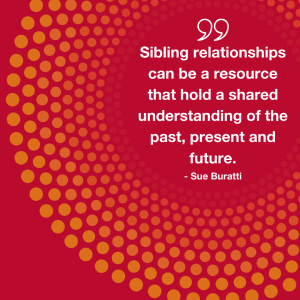
Sibling Relationships in Therapeutic Planning
Children and young people who have experienced trauma have extraordinary relationships with their siblings. For those who cannot live with their birth parents or families, including these relationships in therapeutic planning is extremely important. Sue Buratti explains why.
This article was written by Sue Buratti, Senior Manager of Therapeutic Services in NSW at the Australian Childhood Foundation.
Sibling relationships can be the most rewarding and challenging of all relationships across our lifespan. They can provide an unbreakable connection or can be a source of deep pain.
For children who cannot live with their birth parents, sibling relationships, when safe, can provide “a travelling companion for life”.
Children and young people who have experienced trauma have extraordinary relationships with their siblings. Some cannot live with them and have been torn from the comfort of their bonds and continue to live with intense grief. Some live in new and blended families where they must navigate changed birth order, roles, and family dynamics. And devastatingly, some remain with their siblings who continue to harm them.
However, for those who have relationships that are a resource for wellness, by including these sibling relationships in therapeutic planning, we can assist them to grow and strengthen so they become lifelong narrators of each other’s story.
They can hold the other’s experience like nobody else, they can have a depth of understanding and connection that surpasses any other relationship.
 Siblings can also be echoes of therapeutic messages for each other when their connection is considered in therapeutic planning. They can be a resource that has a shared understanding of the past, present and future.
Siblings can also be echoes of therapeutic messages for each other when their connection is considered in therapeutic planning. They can be a resource that has a shared understanding of the past, present and future.
Take a moment to think about how you can be more inclusive and creative in thinking about the siblings of the Children and Young People you are working for?
It is essential that we consider children’s sibling relationships as part of our therapeutic planning. We already know that it is not just the direct therapeutic relationship that provides the best outcomes, it is the quality and number of relationships that can be rallied and sustained into the future which provides enriched long-term benefits. These relationships will be there long after we have finished our therapy.
Sibling groups may be invisible if they are not noted on a referral or living in the same home together. It is important to think about all the relationships, whether visible or not when planning how we will work with children in OOHC, after all, our creativity and thoughtfulness may provide a connection to someone who will be there for them for the rest of their lives.
